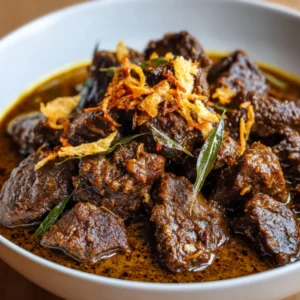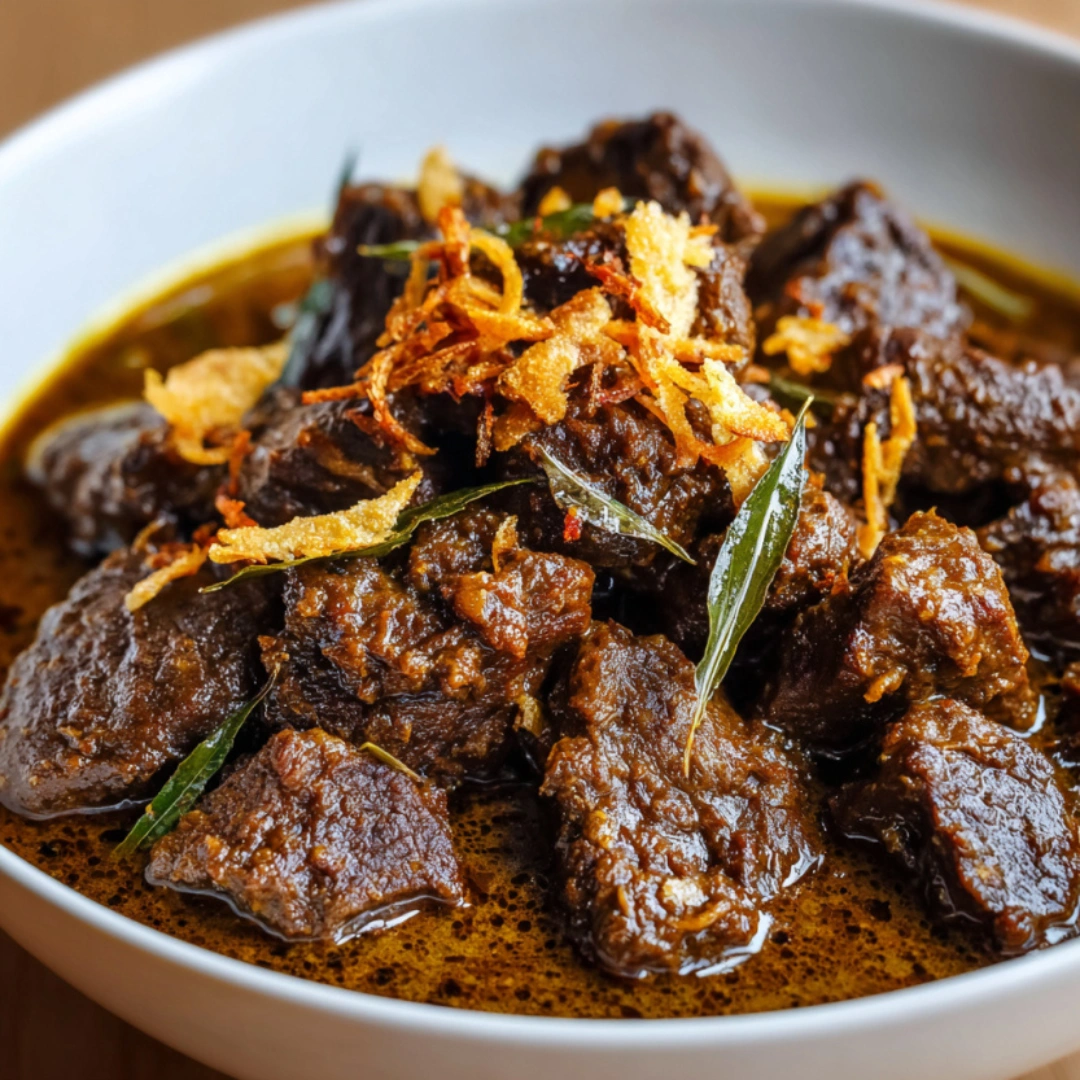If you’ve ever wanted to try a dish that combines bold spices, tender beef, and a rich, creamy sauce, Beef Rendang is a fantastic choice. This traditional Malaysian recipe has a unique flavor profile that comes from a blend of herbs and spices slow-cooked to perfection. When you make Beef Rendang, you get a dish that is both comforting and exotic, perfect for family meals or special gatherings.
Why You’ll Love This Beef Rendang Recipe
You’re going to love this Beef Rendang because it’s packed with deep, complex flavors that develop over hours of slow cooking. The combination of toasted coconut, lemongrass, tamarind, and spices creates a fragrant, hearty meal that feels luxurious but is surprisingly easy to prepare. Whether you’re a seasoned cook or just starting out, this recipe guides you through every step, making it simple to impress your friends and family. Plus, it’s perfect for meal prep and tastes even better the next day.
Ingredients for Beef Rendang
To make this dish your own, you’ll need a variety of fresh and dried ingredients that work together to bring out the authentic taste of rendang.
- 600g to 1kg beef for stewing, such as chuck or short ribs
- 2 stalks lemongrass, bruised to release flavor
- 1 cinnamon stick
- 3 star anise pods
- 5 cloves
- 5 cardamom pods
- 5 to 6 makrut lime leaves, bruised or torn
- 1 teaspoon tamarind paste mixed with 2 tablespoons water (or tamarind juice)
- 500ml coconut cream (or santan)
- 1 tablespoon coconut palm sugar (or gula melaka)
- 2 teaspoons salt, or to taste
- 120g toasted coconut butter (kerisik) — key for that nutty texture
- 1 cup water (if needed during cooking)
- 1/4 cup cooking oil
For the blended spice paste:
- 1 to 2 tablespoons dried chili paste or about 10 dried chilies (soaked and deseeded)
- 1 onion, peeled and chopped roughly
- 4 cloves garlic, peeled
- 1 inch fresh ginger, peeled and chopped
- 1 inch fresh galangal, chopped
- 1 inch fresh turmeric or 1 teaspoon turmeric powder
- 1 teaspoon coriander seeds
- 1 teaspoon fennel seeds
- 1 teaspoon cumin seeds
- 1/4 cup water (optional, for easier blending)
How to Make Beef Rendang: Step-by-Step Directions
Getting your rendang just right is about layering flavors and patience. Follow these steps carefully, and you’ll get a dish that’s bursting with taste and tender in every bite.
Start by preparing the blended spice paste. Put all the ingredients for the paste into a blender or food processor. Add a little water or oil to help blend if your machine needs it. You want a smooth, thick paste that’s full of fragrant spices.
Next, heat your cooking oil in a large pot over medium heat. Add the whole spices — cinnamon, star anise, cloves, and cardamom — and gently sauté for about a minute. This releases their essential oils and adds depth to your dish.
Add the blended spice paste to the pot and cook for about five minutes. Stir frequently until you notice the paste thickening and deepening in color, and the aroma fills your kitchen. This step is crucial for developing the rich base flavor.
Add the bruised lemongrass and your beef pieces. Stir well, making sure the meat is coated in the paste. Keep cooking while stirring occasionally until the beef starts to release its juices and the liquid evaporates. This process usually takes about 10 minutes and allows the meat to absorb the spices deeply.
Pour in the coconut cream along with salt, coconut palm sugar, makrut lime leaves, tamarind paste, and toasted coconut butter (kerisik). Stir everything well and bring it to a boil. Once boiling, reduce the heat to very low and cover the pot.
Let the rendang simmer gently for about two hours. This slow cooking allows the beef to become tender and the sauce to thicken beautifully. Every 20 to 30 minutes, give the pot a stir, scraping the bottom to prevent any burning. If you see the sauce drying out too quickly or the beef still isn’t tender, add a little water.
In the last 30 minutes, watch closely and stir more frequently. The liquid should reduce significantly, and the oil will separate, leaving a thick, fragrant coating on the beef. The dish is done when the beef is tender and the sauce has thickened to your liking.
How to Serve Beef Rendang
When it comes to serving Beef Rendang, simplicity lets the flavors shine. You can enjoy it with steamed white rice or fragrant coconut rice for a classic combination. The rich sauce pairs beautifully with fluffy rice that helps soak up every bit of the delicious coconut and spice mixture.
If you want to add some greens, serve your rendang alongside lightly sautéed vegetables or a fresh cucumber salad. These add a refreshing contrast to the deep, savory flavors of the beef.
For a more festive meal, Beef Rendang is excellent when paired with traditional sides like pickled vegetables, fried shallots, or even some crispy crackers for a textural contrast.
Expert Tips for Perfecting Your Beef Rendang
To get the best results, keep these expert tips in mind:
- Choose the right cut of beef. Cuts like chuck or short ribs have enough fat and connective tissue that break down beautifully during slow cooking, making the meat tender and flavorful.
- Toast your coconut butter (kerisik) well but avoid burning it. It adds a unique nutty flavor that is key to authentic rendang.
- Don’t rush the cooking. Low and slow is the way to go to develop the deep flavors and tender texture.
- Adjust your chili paste depending on your spice preference. You can use milder dried chili paste or increase the amount for a spicier kick.
- Stir often during the last stage to prevent the sauce from burning as it thickens.
- If you can, prepare rendang a day ahead. It tastes even better after the flavors have melded overnight.
How to Store Beef Rendang
You can store leftover rendang in an airtight container in the refrigerator for up to 3 to 4 days. When reheating, do so gently on the stove or in a microwave with a splash of water to loosen the sauce if it has thickened too much.
For longer storage, beef rendang freezes well. Portion it into freezer-safe containers and freeze for up to 2 months. Thaw overnight in the fridge before reheating. The slow cooking and rich sauce help it keep its flavor and texture even after freezing.
Variations of Beef Rendang
If you want to experiment or tailor the dish to your taste, here are some ideas:
- Try using chicken or lamb instead of beef for a different twist. Adjust cooking times accordingly.
- Add potatoes or carrots for a heartier stew with added texture and flavor.
- For a creamier sauce, mix some full-fat coconut milk with coconut cream.
- Use fresh red chilies instead of dried for a sharper, fresher heat.
- Swap tamarind paste for a squeeze of lime juice if you want a brighter citrus note.
- Add a handful of toasted peanuts or cashews for extra crunch at the end.
Frequently Asked Questions About Beef Rendang
What cut of beef is best for rendang?
Choose beef cuts like chuck or short ribs with some marbling. These cuts become tender after slow cooking and absorb the spices well.
Can I make beef rendang without toasted coconut butter (kerisik)?
Kerisik adds a unique nutty flavor and texture, but if you don’t have it, you can try toasted shredded coconut as a substitute. The taste won’t be exactly the same but still delicious.
How spicy is Beef Rendang?
The heat level depends on the amount and type of chili paste you use. You can reduce or increase it to match your preferred spice level.
Can I prepare rendang in advance?
Yes! Rendang actually tastes better the next day as the flavors continue to develop. Just store it properly in the fridge and reheat before serving.
What should I serve with Beef Rendang?
Traditionally, it goes with steamed rice or coconut rice. You can also serve it with vegetables or fresh salads for a balanced meal.
How long does it take to cook rendang?
The slow cooking process takes about two hours to ensure the beef is tender and the sauce is thick and flavorful.

Beef Rendang
Ingredients
- 600 g to 1 beef for stewing such as chuck or short ribs
- 2 stalks lemongrass bruised
- 1 stick cinnamon
- 3 pods star anise
- 5 cloves cloves
- 5 pods cardamom
- 5 to 6 leaves makrut lime bruised or torn
- 1 teaspoon tamarind paste mixed with 2 tablespoons water
- 500 ml coconut cream
- 1 tablespoon coconut palm sugar
- 2 teaspoons salt or to taste
- 120 g toasted coconut butter kerisik
- 1 cup water if needed during cooking
- 1/4 cup cooking oil
For the blended spice paste
- 1 to 2 tablespoons dried chili paste or about 10 dried chilies (soaked and deseeded)
- 4 cloves garlic peeled
- 1 inch fresh ginger peeled and chopped
- 1 inch fresh galangal chopped
- 1 inch fresh turmeric or 1 teaspoon turmeric powder
- 1 teaspoon coriander seeds
- 1 teaspoon fennel seeds
- 1 teaspoon cumin seeds
- 1/4 cup water optional, for easier blending
Instructions
- Prepare the blended spice paste by blending all paste ingredients until smooth.
- Heat cooking oil in a large pot. Add whole spices and sauté for about a minute.
- Add the blended spice paste and cook for about five minutes until thickened and aromatic.
- Add bruised lemongrass and beef. Stir until meat is coated and juices start to evaporate.
- Pour in coconut cream, salt, coconut palm sugar, lime leaves, tamarind paste, and toasted coconut butter. Bring to a boil, then reduce heat and cover.
- Let simmer for about two hours, stirring occasionally and adding water if needed.
- In the last 30 minutes, stir more frequently as the sauce thickens and oil separates.
- Serve with steamed rice or coconut rice.
Send me this recipe!
Just enter your email below and get it sent straight to your inbox!

